The shoot system of the plant is an outgrowth that originates from the plumule of the seed’s embryo above the ground. The term shoot is generally interchangeable with the term stem, as it constitutes the major part of the shoot system.
The morphology and physiology of the shoot system are more complex than the root system of the plant. The main stem is the vertical axis that comprises two segments, namely nodes and internodes.
Nodes are the segments where the leaves get fixed, and internodes are the segments in the middle of two nodes. A shoot is a highly branched and complex structure of the plant that anchorage leaves, buds, flowers and fruits.
Content: Shoot System of Plant
Definition of Shoot System
A shoot refers to the plant’s main stem or the complex network of various structures like branches, leaves, buds, flowers, and fruits attached to the main stem. A shoot or a shoot system always grow upwards to the ground and performs multiple functions like photosynthesis, storage, reproduction, transport, hormone production etc.
Characteristics of Shoot System
A shoot or seedling originates from the plumule of the seed’s embryo and shares the following morphological features:
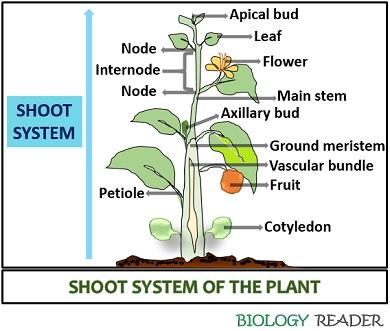
Stem
It functions as a skeleton by constituting a major part of the shoot system and firmly supports the other components like leaves, buds, flowers and fruits. The main stem originates through the direct prolongation of the embryo’s tigellum and gives rise to the lateral stems, leafy appendages, buds etc.
Leaves
These are the flattened structures that hit the node of the main stem and the region in the middle of two nodes or internode. The angle forming between the leaf at the node section and the vertical stem commonly refers to the “Leaf axil”.
Leaves have a basipetal or acropetal pattern. They emerge out via differentiation of the shoot apical meristem. A leaf mainly comprises of three elements, namely:
- Leaf base: It fixes the leaf to the stem’s node.
- Petiole: It is a stalk-like appendage that joins a leaf base to the leaf lamina.
- Leaf lamina: It is the leaf blade that comprises the midrib, veins and veinlets.
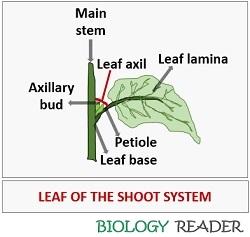
Axillary bud
It commonly refers to a lateral bud or lateral meristem attached to the leaf axil. An axillary bud has two types:
- Type-I or Vegetative kind: It promotes the growth of the vegetative branch.
- Type-II or Floral kind: It gives rise to the flowers from the rudimentary reproductive tissues.
Apical bud
It commonly refers to a terminal bud or terminal meristem found at the plant’s shoot apex. It appears small, compact, and contains apical meristematic tissues. Leaf primordia surround the apical bud.
Apical bud includes three meristematic layers of cells, namely protoderm, procambium and ground meristem. The ground tissues of the apical meristem further divide and differentiate to form vascular tissues that serve the conduction of food materials.
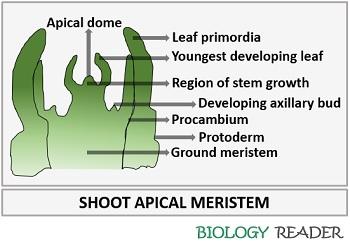
Flower
It constitutes the reproductive part of the shoot system and belongs to the members of angiosperms that are meant to reproduce sexually. A flower involves four characteristic whorls, namely:
- Calyx: The arrangement of sepals collectively refers to the calyx that appears green-coloured, leaf-like and present towards the flower’s base.
- Corolla: The arrangement of petals collectively refers to the corolla that is present above the calyx and appears bright-coloured.
- Androecium: Stamen consisting of filament and anther will collectively constitute androecium or the male reproductive part.
- Gynoecium: Carpel consisting of stigma, style and ovary will collectively constitute gynoecium or the female reproductive part.
Based on the function of floral parts, a flower is classified into the following two types:
- Accessory organs: It includes calyx and corolla that attract the pollinators like a honey bee, butterflies etc.
- Reproductive organs: It includes androecium and gynoecium that encourages the growth and fertilization of the flower.
Fruit
It is the reproductive structure that indicates the maturity or the age of the plant. “Parthenocarpic fruits” lack seed or reproductive parts and produce fruits asexually. An ovary or ovule differentiates into pericarp and seed, respectively, after complete fertilization. When a pericarp is thick, it differentiates into three distinct layers, namely outer epicarp, middle mesocarp and inner endocarp.
Cotyledons
They are the seed leaves or true leaves that germinate after the fertilization of the ovule from the plumule of the mature embryo.
Shoot System Functions
A shoot system of the plant body performs specific functions like:
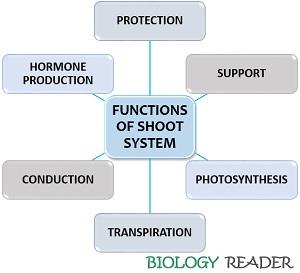
Protection: In some plants, a stem comprises hairy or spiny structures on its surface that harbour a plant from predators. Some plants like bracken produce toxic materials that also keep away the grazing animals.
Support: The ground tissues like sclerenchyma and collenchyma also provide strength and rigidity to the stem. Thus, the stems withstand straight and embrace various components of the shoot system like leaves, lateral branches, buds, flowers etc.
Photosynthesis: Leaves of the shoot system possess chlorenchyma tissue, which contains a high chlorophyll pigment that absorbs light energy to produce sugar. Through photosynthesis, mechanism leaves maintain the proper metabolism.
Transpiration: Both leaves and stems undergo transpiration via stomata and lenticels, which allow gaseous exchange between the plants and the surrounding.
Conduction: A main stem of the shoot system participates in preparing food by the leaves to the other parts via phloem vessels. Besides, the root system facilitates the absorption of water and minerals to the other components via xylem vessels.
Hormone production: A shoot tip produces auxin (a growth regulatory hormone) that stimulates the vertical growth or height of the plant and restricts the growth of axillary bud.
A cytokinin is also a growth-regulating hormone that conquers the inhibitory effect of auxin by stimulating side branching or the growth of axillary bud. The cytokinins increase the diameter or thickness of the plant and give a bushy appearance.
Therefore, both the growth-regulating hormones can manipulate the plant’s growth pattern and can be used widely in the field of agricultural science.
Shoot Development
A shoot develops after embryogenesis, where a zygote inside an ovule goes through successive mitotic division to form a mature embryo. A mature embryo comprises five distinct regions that you could see in the diagram below:
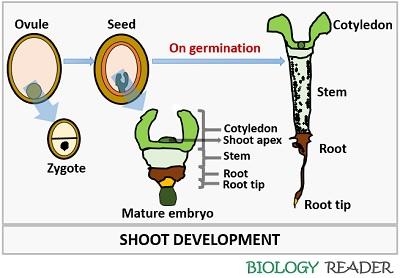
A top green part will produce seed leaves or cotyledons, in between which a shoot apical meristem is present. The shoot apex or the terminal bud will stimulate elongation of the plant. The region below the apical meristem will encourage the growth of the main stem. The below two layers will give rise to the root system of the plant.
nice post
This website is the super website where we can learn more.